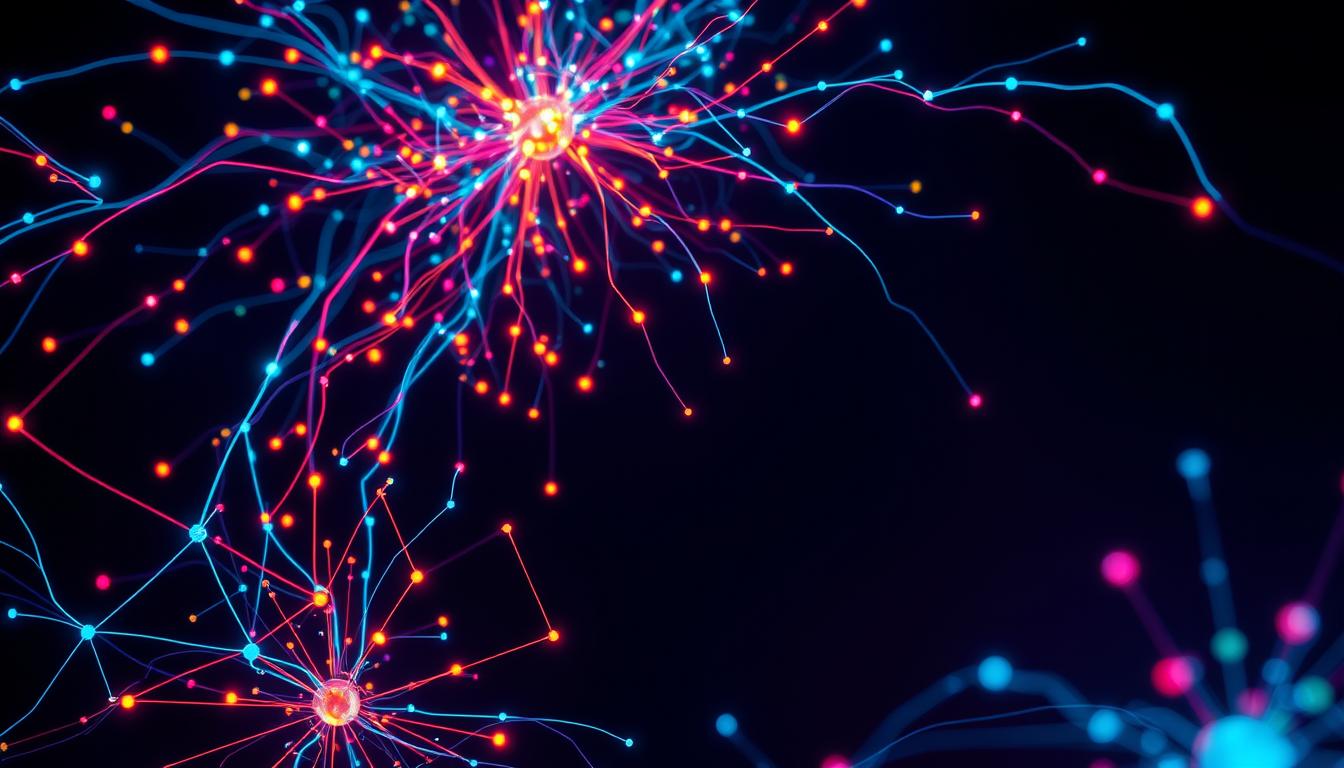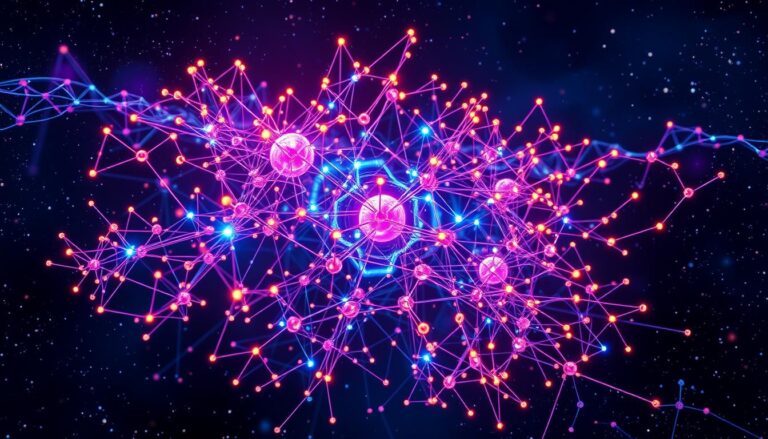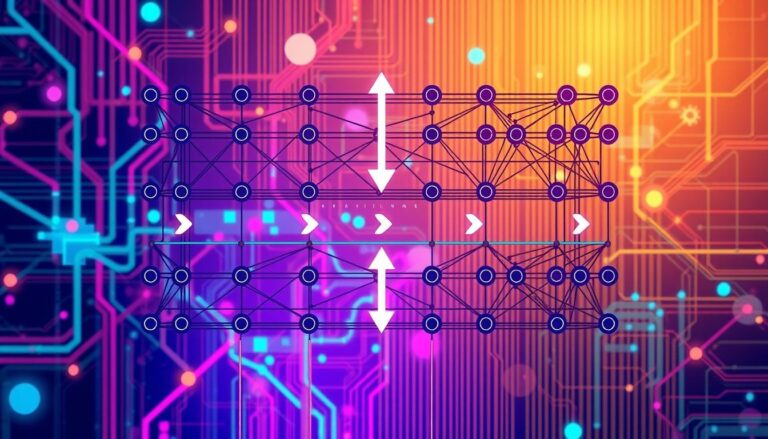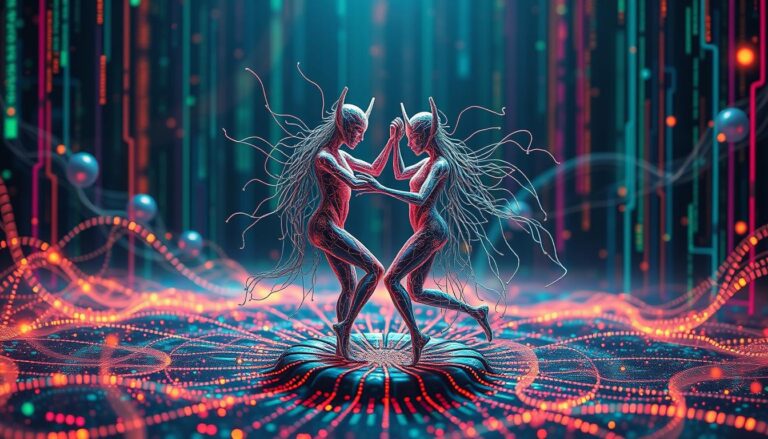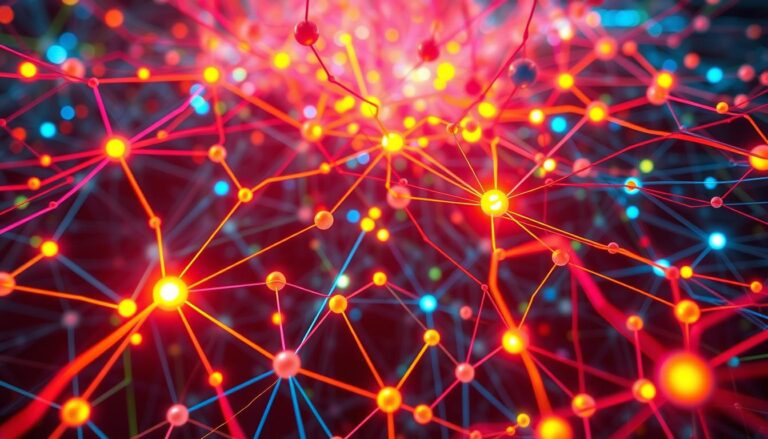What are neural networks, and how do they work in deep learning?
Neural networks are key to deep learning and have been studied for over 70 years. They are like the human brain, with many connections. In the last decade, they’ve become more powerful thanks to better computers and new ways to train them.
Deep learning uses neural networks to make big strides in artificial intelligence. This includes understanding language, seeing images, and predicting outcomes. These advancements have changed many fields.
At their heart, neural networks have many nodes connected in layers. They work like our brain cells, passing data around. With up to 50 layers, they can handle complex tasks better than ever before.
The rise of neural networks is called the “deep-learning revolution.” It’s thanks to faster GPUs, which boost their power. This lets experts unlock the full potential of neural networks, exploring new limits in artificial intelligence.
Introduction to Neural Networks
Neural networks are key to deep learning, leading to big advances in AI in the last decade. They mimic the brain, with nodes that handle and share data like neurons do.
The idea of neural networks started in the 1940s, thanks to Warren McCullough, Walter Pitts, and Frank Rosenblatt. Despite dips, they’ve seen a comeback thanks to better computers and new ways to train them.
Neural networks and deep learning
Neural networks and deep learning solve many problems, like recognizing images and speech. The book “Neural Networks and Deep Learning” teaches about these topics. It’s all about learning from data, just like we do.
The book is a detailed guide for those wanting to learn from data. It shows how to use neural nets to recognize handwritten digits. This shows how the tech works in real life.
Deep learning has made big strides in image recognition. The book shows how powerful neural networks and deep learning are. They’re key to solving many real-world problems today.
Understanding machine learning methods
Machine learning (ML) has four main types: supervised, unsupervised, semisupervised, and reinforcement learning. Supervised learning uses data to make predictions. Unsupervised learning finds patterns without a target.
- Supervised learning tasks include regression and classification.
- Unsupervised learning tasks include clustering, association, and anomaly detection.
- Semisupervised learning works with both labeled and unlabeled data.
The course “Introduction to Deep Learning & Neural Networks with Keras” is very popular. It covers deep learning and neural networks. Many students have given it great reviews.
| Course Statistic | Value |
|---|---|
| Enrolled Learners | 58,441 |
| Course Rating | 4.7/5 (1,579 reviews) |
| Number of Modules | 5 |
| Total Duration | 8 hours |
| Instructor | Alex Aklson |
| Prerequisite Knowledge | Intermediate level, some related experience required |
The History of Neural Networks
The journey of neural networks began in the 1940s. Warren McCullough and Walter Pitts started using electrical circuits to model these systems. In the 1950s, Frank Rosenblatt created the Perceptron, the first neural network that could learn.
But, by the 1960s, neural networks hit a roadblock. The traditional von Neumann architecture dominated computing. People doubted the possibility of expanding single-layer networks into more complex ones. Yet, the 1970s brought a new wave of interest with the creation of multilayered networks.
Deep learning, a key part of neural networks, has its roots in 1943. McCullough and Pitts built a computer model inspired by neural networks. In the 1960s, Henry J. Kelley laid the groundwork for deep learning algorithms.
The 1970s were crucial for deep learning. Kunihiko Fukushima introduced convolutional neural networks with Neocognitron in 1979. Back propagation, essential for training deep learning models, made significant strides in the 1970s. Yann LeCun demonstrated its practical use in 1989 at Bell Labs.
The 1985-1990 Artificial Intelligence winter was a tough time for neural networks. Research and funding dwindled. But, the 2000s brought a new era. Faster computers, GPUs, and large datasets like ImageNet revitalized the field.
Now, neural networks and deep learning lead the charge in artificial intelligence. They’re making waves in image recognition, natural language processing, and predictive analytics. The history of neural networks continues to guide and inspire new discoveries.
Deep Learning
Deep learning has changed the world of artificial intelligence (AI) in the last ten years. It uses neural networks, which are like the human brain. These networks can learn and understand complex data, leading to big AI wins.
The Power of Depth
The depth of neural networks is key. It lets them solve tough problems in computer vision, natural language processing, and predictive analytics. They can find patterns and connections that old machine learning couldn’t.
This depth comes from better computers and new ways to train models. It’s why deep learning is so good at things like recognizing images and understanding speech. It’s changed how we use technology and many industries.
Tackling Challenging Tasks
- Image recognition: Convolutional Neural Networks (CNNs) have changed computer vision. They can classify images, find objects, and segment them well.
- Natural language processing: Recurrent Neural Networks (RNNs) and Long Short-Term Memory (LSTMs) are great at handling text. They help with translation, text creation, and understanding feelings in text.
- Predictive analytics: Deep learning is also good at making predictions. It helps in finance, medicine, and improving processes.
Deep learning is getting better all the time. Its uses are endless, leading to big changes in AI and many areas of life.
How Neural Networks Work
Neural networks are key to deep learning, mirroring the brain’s structure and function. They have nodes, or artificial neurons, connected in layers. Each connection has a weight that affects the network’s overall performance.
Training these networks involves adjusting the weights to reduce errors. This is done through backpropagation, where errors are sent backward to refine the weights.
As more data is fed into the network, it learns to spot patterns and make predictions. Each node processes the data and sends it to the next layer. This process helps the network get better at understanding and performing tasks.
The depth of a neural network is crucial for handling complex tasks. Deep networks, with many hidden layers, can handle detailed data. This is why they’re used in image recognition, natural language processing, and predictive analytics.
Understanding neural networks is key to grasping artificial intelligence’s power. By exploring how nodes and weights work, we can see how AI systems achieve their impressive abilities.
| Key Aspects of Neural Networks | Description |
|---|---|
| Nodes | The basic processing units, modeled after biological neurons, that make up the network. |
| Weights | The numeric values associated with each connection between nodes, determining their influence. |
| Training | The process of adjusting the weights to minimize errors and optimize the network’s performance. |
| Depth | The number of hidden layers in a neural network, which enables it to learn and model complex representations of data. |
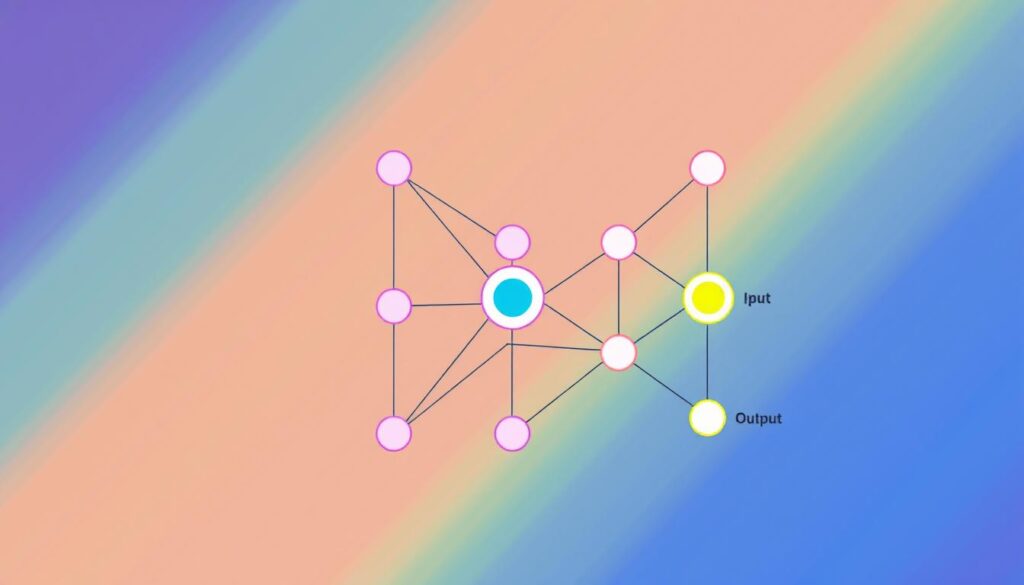
Types of Neural Networks
Neural networks have many forms, each for different tasks in deep learning. They range from feedforward networks for classification to convolutional networks for images and recurrent networks for sequences. This variety is key to unlocking AI’s full potential.
Feedforward Neural Networks
Feedforward neural networks, or multilayer perceptrons (MLPs), are common. They’re used for classification, where inputs are sorted into categories. These networks have layers of nodes that process data, learning complex patterns.
Convolutional Neural Networks
Convolutional neural networks (CNNs) focus on image recognition and computer vision. They use linear algebra techniques to extract features from images. This makes them ideal for tasks like image classification and object detection.
Recurrent Neural Networks
Recurrent neural networks (RNNs) handle sequential data, like text or speech. They have internal memory to capture patterns in sequences. This makes them great for natural language processing and speech recognition.
These examples show the wide range of neural network types for deep learning tasks. As AI evolves, new types will likely emerge, expanding AI’s capabilities even more.
Applications of Neural Networks
Neural networks are key in artificial intelligence and machine learning. They are great at image recognition, natural language processing, and predictive analytics. Their skill in learning complex data makes them essential for solving tough AI and data analysis problems.
For example, they power speech recognition on smartphones and Google’s translation services. They also help virtual assistants like Amazon Alexa and Google Assistant. In healthcare, they aid in disease detection, drug discovery, and diagnosing conditions like cancer and diabetic retinopathy through medical images.
Neural networks help Netflix and Spotify give personalized recommendations. They also help in news aggregation, customizing content, and spotting fake news. Even music composition and generation are done with deep learning models like WaveNet.
- Image colorization through deep learning models like ChromaGAN, transforming grayscale images into colorized images.
- Building robots capable of performing human-like tasks, facilitating activities in hospitals, factories, warehouses, and inventory management.
- Image captioning using recurrent neural networks like LSTM to generate textual descriptions of images.
- Enhancing advertising campaigns by optimizing user experiences, increasing ad relevance, and reducing costs.
- Autonomous driving technologies relying on deep learning for scenario testing, sensor data analyses, and enhancing safety measures.
Neural networks are also changing how we understand and process human language. Visual recognition systems can sort images based on places, faces, events, and dates. This makes image sorting and retrieval easier.
The uses of neural networks are endless, from fraud detection to personalized experiences. As deep learning grows, so does the potential for neural networks to change our lives.

Conclusion
Neural networks have been around since the 1940s. They have seen ups and downs, but keep coming back. This is thanks to better computers and new ways to train them.
These networks are like our brains, with nodes that pass data around. They’re great at tasks like recognizing images and understanding language. Over the last ten years, they’ve made big strides in artificial intelligence.
Neural networks are key to solving complex problems. They help us find new insights. As they get better, they’ll keep changing how we do machine learning and data analysis.
